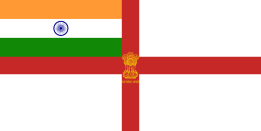List of destroyers of India
_and_INS_Viraat_(R22)_in_the_Arabian_Sea.jpg)
In naval terminology, a destroyer is a fast, manoueverable, long-distance warship intended to escort larger vessels in a fleet, convoy or battle group and defend them against smaller, short-range attackers.[1][2] Sixteen destroyers have served, or currently serve, in the Indian Navy. The navy operates 10 guided-missile destroyers from three classes: Kolkata class, Delhi class, and Rajput class.[3] Six other destroyers (three R class and three Hunt class) have been decommissioned and scrapped.[4][5]
Although destroyers were introduced during the early 20th century and were widely used by the end of World War II, India had none until 1949.[4] The R-class INS Ranjit, built in the United Kingdom, was the first destroyer commissioned in the Indian Navy.[6] Two more R-class ships were later commissioned.[4] Three Hunt-class destroyers were commissioned in 1953 to succeed the R-class destroyers.[5] These ships (all of which were built in the United Kingdom) were decommissioned by 1976, with the Hunt-class INS Godavari the last.[7][8][9]
During the 1980s, India signed an agreement with the Soviet Union for five guided-missile destroyers, built under Rajput class.[10] The first ship (INS Rajput) of the class was commissioned on 30 September 1980. All five Rajput-class ships are still in active service.[11] The Rajput class was succeeded by the Delhi class, with INS Delhi, Mysore and Mumbai commissioned in 1997, 1999 and 2001 respectively.[12] The Delhi-class destroyers, built in India,[12] were succeeded by the Kolkata class in 2014.[13] The three Kolkata-class ships have been commissioned in 2014–2016, with INS Chennai being the last.[14] An improvement of the Kolkata-class, INS Visakhapatnam (part of the Visakhapatnam class), was introduced in April 2015 and will reportedly be commissioned by the end of 2018. Three more vessels are planned as part of the Visakhapatnam class.[15]
Commissioned ships
Ten destroyers from three classes are in active service.[16] INS Kolkata, the lead ship of the Kolkata-class destroyer with about 7,500 tonnes of displacement, is the largest.[14] Of the three proposed Kolkata-class ships, two have been commissioned and the third (INS Chennai) is scheduled to be commissioned by the end of 2016.[13] The Kolkata-class frigates were preceded by the Delhi-class destroyer which entered service with the 1997 of its lead ship, INS Delhi. The Delhi class were the first destroyers built in India. The Rajput-class destroyers, which preceded the Delhi class,[12] consists of five ships built in the Soviet Union and were commissioned from 1980 to 1990.[10]
Kolkata class
The Kolkata class (Project 15A) is a class of guided missile destroyers with stealth technology.[13] By the year 2000, the Indian Navy had redesigned the follow-on Kolkata class to improve technology (including modern stealth characteristics) and in May of that year, approval for the construction was given. Concept and function for Project 15A was framed by the navy's Directorate of Naval Design, while the detailed design was developed by Mazagon Dock Limited (MDL).[17] It consists of three ships (Kolkata, Kochi and Chennai), built by Mazagon Dock Limited, which are the navy's largest destroyers. Due to construction delays and a problem discovered during sea trials, the first ship's commission was postponed from 2010 to 2014.[18]
Although the dimensions of Kolkata-class ships are similar to the previous Delhi class, their weaponry, sensors and helicopter systems have been upgraded.[19] With a standard displacement of 6,800 t (6,700 long tons; 7,500 short tons) and a full-load displacement of 7,400 t (7,300 long tons; 8,200 short tons) (two sources reported a full-load displacement of 7,500 t (7,400 long tons; 8,300 short tons)),[14][20] they are the navy's largest destroyers.[21]
The ships' main air-defence armament is two 4x8-cell vertical launching systems (VLS) allowing up to 32 Barak 8 (medium- to long-range) missiles.[22] Four AK-630 CIWS are fitted for near defence.[13]
The Kolkata-class ships' primary offensive armament is supersonic BrahMos anti-ship and land-attack missiles.[23] The BrahMos missiles are fitted into a 16-cell universal vertical launcher module (UVLM) allowing one missile per launch silo; all 16 missiles can be fired in salvo.[24] A distinctive armament of the Kolkata class is its 76 mm (3.0 in) gun forward of the bridge. The 76 mm gun provides limited anti-shipping and anti-air capability in addition to naval gunfire support for land-based operations.[13] For anti-submarine warfare, the class is equipped with a torpedo-launching system (with four torpedo tubes) and two RBU-6000 anti-submarine rocket launchers.[13][25] Bharat Electronics Limited's electronic modular command and control applications (EMCCA) Mk4 provides combat management.[26]
| Ship | Picture | Armament | Displacement | Service | Origin | |
|---|---|---|---|---|---|---|
| Laid down | Commissioned | |||||
| INS Kolkata (D63)[21][27] | |
7,400 tonnes[28] | September 2003[21] | 16 August 2014[21] | India[13][16] | |
| INS Kochi (D64)[29][30] | .jpg) |
7,500 tonnes[29] | 25 October 2005[29] | 30 September 2015[29] | ||
| INS Chennai (D65)[31] | February 2006[32] | 21 November 2016[31][33] | ||||
Delhi class
The Delhi-class vessels are the third-largest warships designed and built in India, after the Kolkata-class destroyers and the Shivalik-class frigates. They were built by Mazagon Dock Limited in Mumbai.[16] Delhi-class design has Soviet and Western influences, incorporating elements of the Sovremenny, Rajput and Kashin-II-class destroyers and the Godavari-class frigate.[12]
The ships are fully fitted with flag facilities, such as their capability of operating in a NBC environment, and also Radar cross-section reduction is presumed to be minimal, to the extent that some sharp angles are flattened.[34] For primary air defence, a pair of two 3S-90 launchers (one forward of the bridge and the other atop the dual helicopter hangar) are fitted with the Shtil SAM system. The system consists of 24 Russian Shtil missiles in a below-deck magazine. The launchers elevate up to 70°, with a firing arc of 30° within the centreline. The launcher groups, which require a 20-man crew, weigh about 50 tons.[34]
The Delhi class is being upgraded with the Rafael Barak 1 point air defence missile system, correcting the Shtil system's limited firing arc. It has an eight-cell vertical launch system and missile command-to-line-of-sight (CLOS) radar guidance with a range from 500 m (1,600 ft) to 10 km (6.2 mi). The missiles' maximum range is 32 km (20 mi). The ship has a surveillance capacity of over 350 km (220 mi) and can recon over an area of 250 km (160 mi).[34][35]
The ships have a five 533 mm (21 in) torpedo tubes, which can be used to launch SS-N-15 "Starfish" or SS-N-16 "Stallion" ASW missiles, and is capable of hitting targets ranging from 50 km (31 mi) to 120 km (75 mi). They are equipped with two RBU-6000 anti-submarine rocket launchers with 12 tubes. Their range is 6 km (3.7 mi), and the maximum engagement depth is 500 m (1,600 ft).[34]
| Ship | Picture | Armament | Displacement | Service | Origin | |
|---|---|---|---|---|---|---|
| Laid down | Commissioned | |||||
| INS Delhi (D61) |
|
6,200 tonnes[12] | 12 December 1992[12] | 15 November 1997[12] | India[12][16] | |
| INS Mysore (D60) | 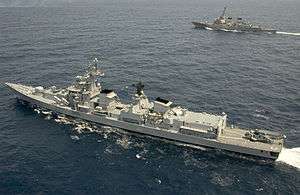 |
12 December 1992[12] | 2 June 1999[12] | |||
| INS Mumbai (D62) | _underway.jpg) |
12 December 1992[12] | 22 January 2001[12] | |||
Rajput class
The Rajput-class guided-missile destroyers built for the Indian Navy (also known as Kashin-II class) are modified versions of Soviet Kashin-class destroyers. The ships were built in the former Soviet Union with Indian modifications to the Kashin design. These included the replacement of the helicopter pad in the original design with a flight elevator (to transports flights, aircraft, and helicopters, from hangar deck to flight deck, and changes to the electronics and combat systems. Five units were built for export to India during the 1980s.[10]
The Rajput class inherited its anti-aircraft and anti-submarine warfare roles for aircraft carrier task-force defence against submarines, low-flying aircraft and cruise missiles from the Kashin class. They were the first ships in the Indian Navy to deploy the BrahMos supersonic cruise-missile systems, deployed during a mid-life refit of the ships. The missile system has four missiles in inclined, bow-mounted launchers (replacing two SS-N-2D Styx AShM launchers in INS Rajput) and an eight-cell VLS system replacing INS Ranvir and INS Ranvijay's aft S-125M (NATO: SA-N-1) SAM launchers. Ranvijay was deployed with an updated vertical launcher for the BrahMos missile.[10][11][36] The Indian Navy is planning to upgrade the propulsion of Rajput-class ships with an indigenously-developed Kaveri marine gas turbine (KMGT) engine. The Defence Research and Development Organisation Gas Turbine Research Establishment is developing this engine, which is currently being tested.[37]
| Ship | Picture | Armament | Displacement | Commissioned | Origin |
|---|---|---|---|---|---|
| INS Rajput (D51) | .jpg) |
|
4,974 tonnes[11] | 30 September 1980[11] | India[10][16] [11] |
| INS Rana (D52) | 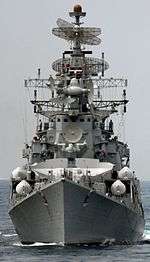 |
28 June 1982[11] | |||
| INS Ranjit (D53) | .jpg) |
|
24 September 1983[38] | ||
| INS Ranvir (D54) | .jpg) |
|
28 August 1986[11] | ||
| INS Ranvijay (D55) | 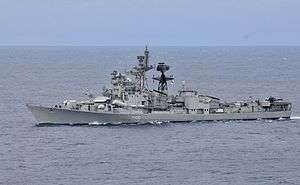 |
21 December 1987[39] |
Decommissioned ships
All presently-decommissioned Indian Navy destroyers were built in the United Kingdom. The R-class INS Ranjit was the first destroyer commissioned by the navy; two more R-class ships were later commissioned.[4] Three Hunt-class destroyers were commissioned in 1953 to succeed the R-class destroyers.[5] The R-class INS Rana was decommissioned on 30 June 1973, the first decommissioned destroyer. It was followed by INS Rajput in 1973, INS Ranjit, INS Gomati and INS Ganga in 1975 and INS Godavari in 1976. All the British-built ships were decommissioned by 1976.[4][5]
R class
The R class was a class of sixteen War Emergency Programme destroyers ordered for the Royal Navy in 1940 as the 3rd and 4th Emergency Flotilla. The Q and R class repeated the preceding O and P class, reverting to the larger J, K and N-class hull to allow for increased top weight (maximum permissible weight). Since they had fewer main guns than the J, K and Ns, magazine space was replaced by fuel bunkers[40] allowing for 4,675 nautical miles (8,658 km) at 20 knots (37 km/h) (compared with the 3,700 nmi (6,900 km) of their ancestors). Like the O and P classes, they were armed with available weapons: 4.7-inch (120 mm) guns on single mountings allowing only 40° of elevation. As a result, on paper they do not compare favourably with many of their contemporaries. These ships used the Fuze Keeping Clock HA Fire Control Computer.[41] The R class repeated the Qs, except that the officers' accommodation was moved from the traditional right aft to a more accessible location amidships.[40][42]
| Ship | Picture | Armament | Displacement | Service | Origin | Fate | |||
|---|---|---|---|---|---|---|---|---|---|
| Laid down | Commissioned (Royal Navy) |
Commissioned (Indian Navy) |
Decommissioned | ||||||
| INS Rajput (D141)[Note 1][6] | 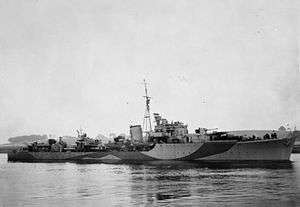 |
|
2,449 tonnes[40][42] | 10 April 1941[40][42] | August 1942[40][42] | 27 July 1949[40][42] | 1976[40][42] | United Kingdom [40][42] | scrapped[4][43] |
| INS Ranjit (D209)[Note 2][44] | 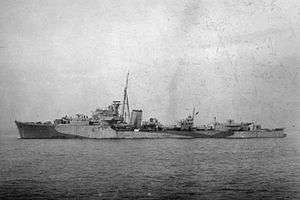 |
19 June 1941[40][42] | 1 October 1942[40][42] | 1949[40][42] | 1979[40][42] | ||||
| INS Rana (D115)[Note 3][45] |  |
1941[40][42] | 16 November 1942[40][42] | 1949[40][42] | 1976[40][42] | ||||
Hunt class
The Hunt class was a class of Royal Navy escort destroyer. The first ships were ordered early in 1939 and the class saw extensive service in World War II, particularly on the British east coast and in Mediterranean convoys. The Hunts were modelled on the 1938 escort sloop Bittern, a 262-foot (80 m) ship of 1,190 tons with 3,300 shp (2,500 kW) on geared turbines for 18 3⁄4 knots and an armament of three twin Mark XIX mounts for the QF 4-inch (102 mm) Mark XVI gun. The guns were controlled by a Fuze Keeping Clock AA fire-control computer when engaging aircraft. The Hunt class had the same armament with a quadruple QF 2-pounder-mount Mark VII on a hull of the same length, but with 8 feet (2 m) less beam and installed power raised to 19,000 shp (14,000 kW) to give 27 knots (50 km/h). The first twenty were ordered in March and April 1939. They were constructed to Admiralty standards (like contemporary destroyers), unlike frigates which followed mercantile practice.[46][47][48]
| Ship | Picture | Armament | Displacement | Service | Origin | Fate | |||
|---|---|---|---|---|---|---|---|---|---|
| Laid down | Commissioned (Royal Navy) |
Commissioned (Indian Navy) |
Decommissioned | ||||||
| INS Godavari (D92)[Note 4] |
 |
|
1,450 tonnes[7] | 1940[7] | 17 April 1942[7] | 27 April 1953[7] | 1976[7] | United Kingdom[48] | scrapped[43][8][9][48] |
| INS Gomati (D93)[Note 5] |
 |
|
10 April 1940[8] | 16 August 1941[8] | 24 April 1953[8] | 1975[8] | |||
| INS Ganga (D94)[Note 6] |
 |
1 March 1940[9] | October 1941[9] | 18 June 1953[9] | 1975[9] | ||||
Future ships
The Visakhapatnam class, with enhanced attack and stealth capabilities, are planned to succeed the Kolkata class. Of the four Visakhapatnam-class ships, two (INS Visakhapatnam and INS Mormugao) are under construction and the other two (INS Mormugao and INS Paradip) are in the planning stage.[49]
Visakhapatnam class
The Visakhapatnam class (Project 15B) is a class of stealth guided missile destroyers under construction. An improved version of the Kolkata class and ordered in 2011, the first Visakhapatnam-class ship is expected to be completed in 2018.[50][51] The class will have enhanced stealth characteristics and state-of-the-art weaponry and sensors, including the long-range Barak 8 surface-to-air missile. The first ship's keel was laid in October 2013. The Visakhapatnam class will be armed with a 127 mm main gun and an AK-630 close-in anti-missile gun system.[52][53]
| Ship | Armament | Displacement | Laid down | Launched | Status | Origin |
|---|---|---|---|---|---|---|
| INS Visakhapatnam (D66) | 7,400 tonnes[56] | October 2013[56] | 20 April 2016[56] | Under construction | India[15] | |
| INS Mormugao (D67) | 4 June 2015[57] | 17 September 2016[57] | Under construction | |||
| INS Paradip (D68) | Pending | Pending | Planned | |||
| INS Porbandar (D69) |
See also
- List of active Indian Navy ships
- Future of the Indian Navy
- List of ships of the Indian Navy
- List of submarines of the Indian Navy
- List of frigates of the Indian Navy
Notes
Footnotes
Citations
- ↑ "Definition of destroyer". Oxford University Press. Retrieved 24 July 2016.
- ↑ "Definition of Destroyer". Merriam Webster. Retrieved 24 July 2016.
- ↑ "Surface Ships". Indian Navy. Ministry of Defence, Government of India. Retrieved 10 July 2016.
- 1 2 3 4 5 6 7 Pike, John. "R-Class". GlobalSecurity.org. Retrieved 10 July 2016.
- 1 2 3 4 "Hunt class Destroyers". Naval History. Retrieved 16 October 2016.
- 1 2 "HMS Rotherham (H 09)". Naval History. Retrieved 10 July 2016.
- 1 2 3 4 5 6 7 "ORP Slazak, Polish escort destroyer, ex-HMS Bedale". Naval History. Retrieved 10 July 2016.
- 1 2 3 4 5 6 7 "HMS Lamerton, escort destroyer". Naval History. Retrieved 10 July 2016.
- 1 2 3 4 5 6 7 "HMS Chiddingfold, escort destroyer". Naval History. Retrieved 10 July 2016.
- 1 2 3 4 5 6 7 8 9 "Rajput Class Guided-Missile Destroyer". Military Today. Retrieved 10 July 2016.
- 1 2 3 4 5 6 7 8 9 10 11 Pike, John. "D 51 Rajput Class". GlobalSecurity.org. Retrieved 10 July 2016.
- 1 2 3 4 5 6 7 8 "Kolkata Class Guided Missile Destroyers". Naval Technology. Retrieved 10 July 2016.
- 1 2 "Project 15B Improved Kolkata Class Destroyer". GlobalSecurity.org. Retrieved 16 October 2016.
- ↑ Shukla, Ajai. "World-class warships at Indian prices". Business Standard. Retrieved 9 September 2016.
- ↑ "Navy's ongoing hunt for heavy torpedoes leads to delay in modernisation process". India Today. 10 June 2013. Retrieved 20 July 2013.
- ↑ Shukla, Ajai (20 August 2012). "Dangerous consequences of warships built in India". Rediff News. Retrieved 9 June 2014.
- ↑ "Largest destroyer project of Navy hit by delay". Defence Express. 6 June 2013. Retrieved 15 July 2014.
- 1 2 3 4 "INS Kolkata". Indian Navy. Retrieved 10 July 2016.
- ↑ "On INS Kolkata, PM is Only Partially Correct". NDTV. Retrieved 29 July 2016.
- ↑ "First test of BrahMos land-attack variant from the sea". India Today. 5 March 2008. Retrieved 17 July 2013.
- ↑ "BrahMos missile test-fired from warship INS Kolkata". The Times of India. 9 June 2014. Retrieved 9 June 2014.
- ↑ "Project 15-A Improved Delhi / VIshakhapattanam / DDGHM Kolkata". GlobalSecurity.org. Retrieved 16 June 2013.
- ↑ "India welcomes its first home-built warship". Daily Mail UK. Retrieved 10 July 2016.
- 1 2 "Largest-ever 'Made-in-India' warship INS Chennai commissioned". The Times of India. 21 November 2016. Retrieved 21 November 2016.
- 1 2 3 4 "Delhi Class". Naval Technology. Retrieved 29 July 2016.
- ↑ "D Dehli Class". GlobalSecurity.org. Retrieved 29 July 2016.
- ↑ Makiyenko, Konstantin (22 August 2011). "BrahMos sets the 'gold standard' for Russian-Indian defence projects". Russia & India Report. Retrieved 1 August 2016.
- ↑ Muhammad 1999, p. 276.
- ↑ Shankar 2005, p. 236.
- 1 2 3 4 5 6 7 8 9 10 11 12 13 14 15 16 Friedman 2012, pp. 88–90, 94, 98–99, 107, 138.
- ↑ Hodges 1979, p. 15.
- 1 2 3 4 5 6 7 8 9 10 11 12 13 14 15 Friedman 2011, p. 102.
- 1 2 Singh 1992, p. 56.
- ↑ "HMS Redoubt, destroyer; INS Ranjit". Naval History. Retrieved 10 July 2016.
- ↑ "HMS Raider; INS Rana". Naval History. Retrieved 10 July 2016.
- ↑ "British Hunt-class escort destroyers, WW2". Naval History. Retrieved 29 July 2016.
- ↑ Helgason, Guðmundur. "Allied Warships of WWII: Escort destroyers – Hunt (Type I) class". Uboat.net. Retrieved 29 July 2016.
- 1 2 3 Helgason, Guðmundur. "Allied Warships of WWII: Escort destroyers – Hunt (Type II) class uboat.net". Uboat.net. Retrieved 29 July 2016.
- ↑ "Bengaluru's loss is Vizag's gain in naming warship". Deccan Herald. Retrieved 11 July 2016.
- ↑ "Navy's Next Destroyer Line Christened Visakhapatnam-class, 1st Launch Next Week". LiveFist defence. 15 April 2015. Retrieved 16 April 2015.
- 1 2 3 Gady, Franz-Stefan. "China Beware: Here Comes India's Most Powerful Destroyer". The Diplomat. Retrieved 1 May 2016.
- ↑ Som, Vishnu (17 April 2015). "All About the INS Visakhapatnam, Navy's Most Powerful Destroyer". NDTV. Retrieved 16 April 2015.
- ↑ "Keel Laid For Yard 12704 (1st ship of P15 Bravo)" (PDF). Mazagon Dock Shipbuilders. 12 October 2013. Retrieved 9 June 2014.
- ↑ Dutta, Sujan (28 November 2015). "Israel ship missile test for India". The Telegraph. Retrieved 16 October 2016.
- ↑ Pandit, Rajit (28 November 2015). "Gen Next missile defence shield built by Israel and India clears first hurdle". The Times of India. Retrieved 16 October 2016.
- 1 2 3 4 "INS Visakhapatnam: 11 things you need to know about India's latest destroyer warship | Latest News & Updates at Daily News & Analysis". Daily News and Analysis. 20 April 2015. Retrieved 17 October 2016.
References
- Friedman, Norman (2012). British Destroyers & Frigates: The Second World War & After. Barnsley, United Kingdom: Seaforth Publishing. ISBN 978-1-84832-015-4.
- Friedman, Norman (2011). Naval Weapons of World War One. Barnsley, United Kingdom: Seaforth Publishing. ISBN 978-1-84832-100-7.
- Gove, Philip Babock, ed. (2002). Webster's Third New International Dictionary of the English Language. Merriam-Webster.
- Hodges, Peter (1979). Destroyer Weapons of World War 2, Volume 3 of Warship Special. Greenwich, United Kingdom: Conway Maritime Press. ISBN 978-0-85177-137-3.
- Muhammad, Mahmood bin (1999). A Policeman Ponders: Memories and Melodies of a Varied Life. New Delhi, India: APH Publishing. ISBN 978-81-7648-026-0.
- Shankar, Prasad (2005). The Gallant Dogras: An Illustrated History of the Dogra Regiment. New Delhi, India: Lancer Publishers. ISBN 978-81-7062-268-0.
- Singh, Satyindra (1992). Blueprint to Bluewater: The Indian Navy, 1951–65. New Delhi, India: Lancer International. ISBN 978-81-7062-148-5.
Further reading
- Lenton, H.T. (1998). British & Empire Warships of the Second World War. London, United Kingdom: Greenhill Books. ISBN 978-1-55750-048-9.
- Lyon, David (1996). The First Destroyers. London, United Kingdom: Chatham Publishing. ISBN 1-55750-271-4.
External links
